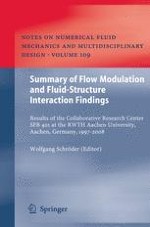2010 | Buch
Summary of Flow Modulation and Fluid-Structure Interaction Findings
Results of the Collaborative Research Center SFB 401 at the RWTH Aachen University, Aachen, Germany, 1997-2008
herausgegeben von: Wolfgang Schröder
Verlag: Springer Berlin Heidelberg
Buchreihe : Notes on Numerical Fluid Mechanics and Multidisciplinary Design
